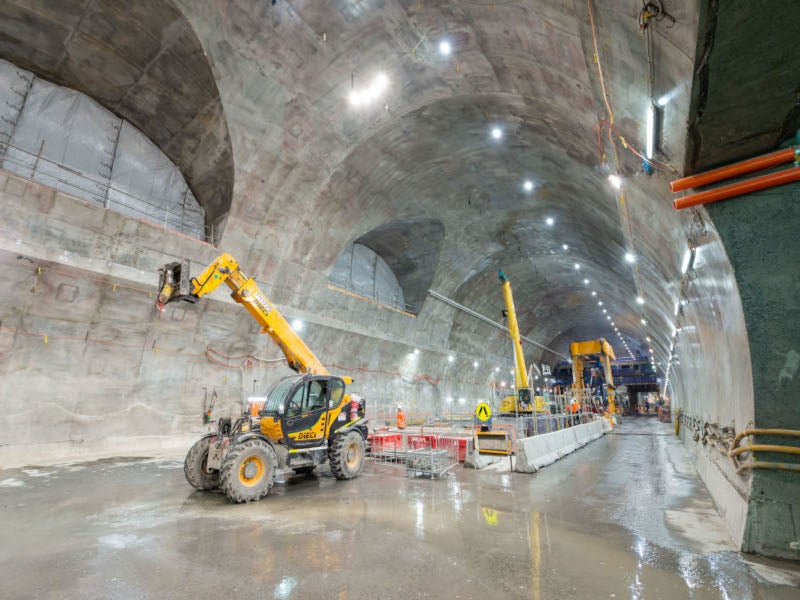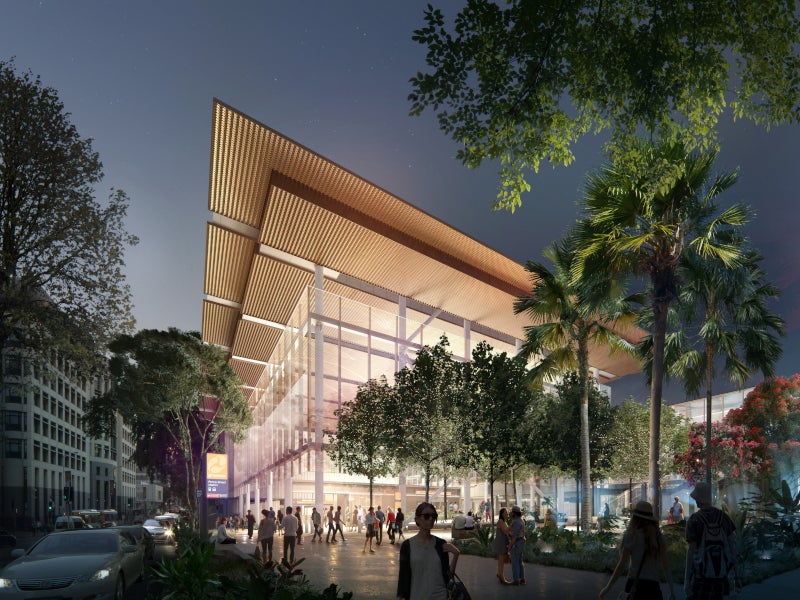Cross River Rail is a new rail line under construction between Dutton Park and Bowen Hills, two major suburbs of Brisbane, Queensland, Australia.
The line will provide a new north-south rail connection beneath the Brisbane River and relieve the congestion on the Brisbane city rail network.
Cross River Rail Delivery Authority (CRRDA) is the lead agency for the development, procurement and delivery of the Cross River Rail project.
The high-priority infrastructure project aims to address capacity constraints in the network.
Cross River Rail, the state’s largest public transport infrastructure project, will revolutionise travel throughout South East Queensland (SEQ).
The project will deliver benefits such as faster journeys, convenient location of stations and the potential to enhance rail services as the population increases.
Major construction work on the project started at the end of 2019. Construction is expected to be completed in 2025. The project is scheduled to commence operations in 2026.
Cross River Rail project background
Most of the new rail infrastructure projects in SEQ in the past two decades have been concentrated on improving connections to the outer suburbs of Brisbane. Some of the major projects include the Redcliffe Peninsula Line (formerly known as Moreton Bay Rail Link), the Springfield Line and the extension of the Gold Coast line to Varsity Lakes.
No major rail infrastructure investment has been made in inner-city Brisbane or river crossings since 1996, which has resulted in significant pressure on the congested inner-city network. In addition, the forecast population and employment growth for the SEQ region are anticipated to lead to increased private vehicle and public transport congestion. With just one rail connection across the Brisbane River, it is difficult to address future growth.
The Queensland Government decided to revitalise and transform the SEQ public transport network, starting with the construction of Cross River Rail, which is designed to provide superior inner-city capacity and connectivity to the north and south.
Since 2008, the government has been conducting a number of studies to assess the feasibility of a range of transport solutions, including trams, augmented busways, a metro system and heavy rail connections of different lengths. It initially proposed an 18km link for the Cross River Rail project from Bowen Hills to Salisbury, which provides connectivity only to the south and leaves the northern suburbs with minimal benefits, at a significant cost of more than $8bn.
It was later modified to ensure the new infrastructure will be at the heart of the rail network, connecting the northern and southern lines.
Cross River Rail project details
The Cross River Rail project will provide a new 10.2km rail connection, which will be a second inner city rail river crossing between Bowen Hills in the north to Dutton Park in the south.
It will also include twin 5.9km tunnels, which will begin at the southern portal north of Dutton Park station and run under Brisbane River and Brisbane central business district, before exiting the northern portal south of the Exhibition station. The tunnels will feature European Train Control System Level 2 (ETCS L2).
The project includes the construction of four new underground stations at Boggo Road, Woolloongabba, Albert Street and Roma Street, while eight aboveground stations are being upgraded at Dutton Park, Exhibition Showgrounds, Fairfield, Rocklea, Moorooka, Salisbury, Yeerongpilly and Yeronga. It will also include the provision of a new track from the portal around the Exhibition Loop and through to Mayne Yard and additional stabling at Mayne North Yard.
Other enabling works will include bi-directional signalling from Dutton Park to Salisbury stations and southern platform faces.
Three new stations, namely Pimpama, Hope Island and Merrimac, are being built on the Gold Coast Line as part of the Cross River Rail project. Construction of the Pimpama station is underway, while construction of the other two Gold Coast stations is yet to begin.
Station locations on the Cross Rail River line
The Boggo Road station will serve passengers in the south, students accessing the University of Queensland and visitors to Princess Alexandra Hospital. By 2036, the new Boggo Road station is expected to serve about 22,000 commuters a day during weekdays.
By providing multi-modal public transport connectivity, the Woolloongabba station will improve the accessibility to health, education and entertainment landmarks.
The new station at Albert Street will be centrally located, providing easy access to William Street, Queen Street Mall, the Botanic Gardens, Queensland University of Technology and the Queen’s Wharf Development. It will further ease the demand for the Central Station, which provides access to the same locations.
The Queen Street Mall will also be accessible from a second station entrance close to Elizabeth Street.
A new station at Roma Street, which is consistent with the Brisbane City Council’s City Centre Master Plan, will attract significant investment to the area.
Roma Street will connect passengers with the existing suburban bus, rail, regional and inter-state bus and train services.
The Merrimac station is planned to be located off Gooding Drive, roughly 750m east of the interchange between Pacific Motorway and Gooding Drive. The Hope Island station is proposed to be built off Hope Island Road, near Mangrove Jack Park.
The Pimpama station will be located off the Old Pacific Highway in the northern suburb of Gold Coast, Queensland.
Construction details of Cross River Rail
A pilot has been built on the Shorncliffe Line as part of Stage 1 of the implementation of ETCS L2. Testing on the line is continuing to ensure a seamless transition between Queensland Rail’s existing signalling system and the new ETCS digital signalling system.
A low-speed ETCS dynamic test was successfully completed on the Shorncliffe line for a train from Queensland’s New Generation Rollingstock (NGR) fleet in May 2023.
The test marks a significant milestone in preparing the NGR rolling stock to operate through the twin tunnels of the Cross River Rail system.
Mayne Yard North, an expansion of the Mayne Yard stabling yard, started operation in January 2023. It was built as part of the Cross River Rail project and handed over to Queensland Rail.
The stabling yard can accommodate 17 six-car trains, increasing the stabling capacity at the inner-city depot to 66 six-car trains.
Yeronga station was reopened to train services in March 2022. Large sections of the old, outdated station were demolished and rebuilt. Most of the construction has been completed, while minor works are ongoing. The station is now accessible via three lifts and a new pedestrian overpass.
Contractors involved in the Cross River Rail project
A consortium named PULSE was selected to implement the tunnel, stations and development (TSD) package in April 2019. The contract for the TSD package comprising the construction of the 5.9km twin tunnels and four new underground stations was finalised in July of the same year.
The PULSE consortium comprises CIMIC Group companies, CPB Contractors, Pacific Partnerships, UGL and international partners including BAM, DIF and Italian real estate builder and construction company Ghella.
UNITY Alliance, a consortium comprising CPB Contractors, Jacobs, UGL and AECOM, was engaged to deliver the rail, integration and systems (RIS) works package. The alliance is delivering the RIS works with support from partners RCS Australia, Acmena, HASSELL, WIRED Overhead Solutions and Martinus Rail.
The RIS contract includes providing critical operational, signalling and other support systems. In addition to the design, supply and installation of rail support systems, the contractual scope also includes works for the integration of Cross River Rail into the wider network of Queensland Rail, as well as upgrades to stations.
The Sequence Alliance comprising Hitachi Rail, Queensland Rail and CRRDA is performing the ETCS L2 works.
ADCO Constructions was appointed to design and build the new Pimpama train station in February 2023.
Acciona Georgiou Joint Venture was engaged in an early contractor involvement phase for the Hope Island station. The joint venture, which comprises Acciona Construction Australia and Georgiou Group, was appointed to design and construct the Hope Island station in September 2022.
Financing details
The Queensland Government is investing A$6.3bn ($4.21bn) and an additional A$1.5bn ($1bn) investment has been secured through public-private partnerships.






